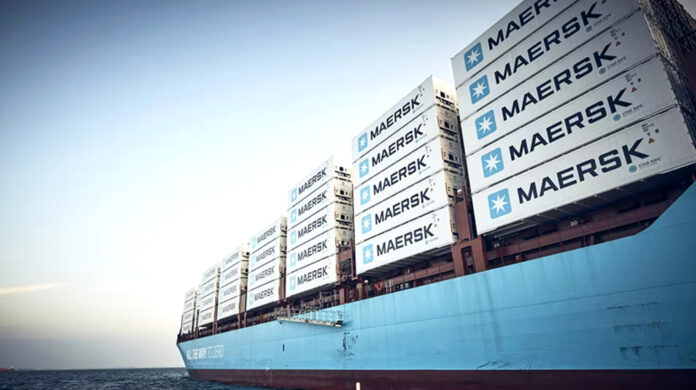Danish shipping company A.P. Moller-Maersk (Maersk) has recruited a whole ecosystem of private network and IoT solutions providers to start work on a new LTE ‘connectivity platform’ called OneWireless to connect 450 vessels. The move will pave the way for smarter cargo tracking, it said. Its band of tech suppliers include Onomondo, Nokia, 42com Sat, Complea, and Zededa, and will see a total overhaul of its current 2G comms and IoT system.
The OneWireless private IoT platform is presented as a “single, unified network to support multiple wireless technologies”, including NB-IoT, Cat-M, and LTE broadband, as well as an upgrade path to 5G, plus interoperability with public networks. It stated: “[It ensures] Maersk customers’ cargo is reliably monitored whether at sea, in port, or on land – thus enabling bring-your-own IoT (BYOIoT) solutions based on standards for customers.”
It will be installed on Maersk-owned vessels and more than 100 time-chartered vessels in the fleet. The upgrade involves hardware replacements aboard vessels, to be carried during scheduled port calls. The roll-out has started, and will be completed by the first quarter of 2026. The platform will provide sundry IoT sensor connectivity, including asset tracking, environmental monitoring, and quality control. The firm will be able to pass the operational benefits to clients.
Kjeld Dittmann, head of vessel and cargo connectivity at Maersk, said: “This platform is designed to support thousands of IoT devices, ensuring optimal performance for reefer tracking and fleet IoT. This upgrade… is comparable to the shift consumers experienced moving from 2G to 4G… [This will] transform how it is possible to communicate with cargo aboard.”
At least some of its suppliers stuck out press notes to proclaim their roles in the project. Both Onomondo and Nokia talked about their roles to string-up private 4G/LTE across Maersk’s ships. Danish firm Onomondo appears to be the mainstay in the exercise, listed first in the Maersk release, and with the fullest information of its own. It called the deployment the “world’s largest private LTE network at sea”, and claimed authorship of the private LTE core network.
This will be deployed in every ship, it said. It stated: “This onboard core network creates a resilient, private LTE environment that remains fully operational even when satellite connectivity is unavailable, eliminating communication blind spots that have long held back the potential of maritime IoT with new efficiency and innovation… Unlike traditional maritime setups that rely on complex coordination across multiple systems, [this is] a single network.”
Devices can automatically and securely switch between the vessel’s private LTE network and public terrestrial LTE networks without SIM swaps or manual reconfiguration. Onomondo has an MVNO deal with 700-odd operators globally; its system supports third-party MNO SIMs, as well. Other features include “an entire at-sea LTE core… across 450 vessels in the Maersk fleet, ensuring continuous IoT operation regardless of satellite comms.”
For its part, Finnish vendor Nokia, the leading player in the private networks game, said it has a contract with Maersk to “equip 450 vessels in its fleet with Nokia’s industry-leading private wireless network solutions”. The press note was from its mobile networks team, rather than its enterprise solutions division, which handles its DAC and MXIE matters, typically geared to Industry 4.0 customers like Maersk. The deal is for Nokia’s radios, rather than these products.
It clarified that the (OneWireless / Onomondo) solution uses Nokia’s small cells portfolio, including its Shikra Remote Radio Heads (RRH) and compact baseband, plus custom antennas. It said: “Each vessel has a small core connected to the radio, utilizing satellite comms for backhaul.” Nokia’s network management system, MantaRay NM, is to be installed in Maersk’s operations center for a “consolidated network view for optimal monitoring and management”.
Nokia stated: “The new unified mobile network powered by Nokia’s radio portfolio is designed to support numerous IoT devices and secure interoperability between private and public networks, ensuring Maersk customers’ cargo is reliably monitored at sea, port, or land. This is especially important for tracking parameters such as temperature and humidity for fruit and other perishables.”
Meanwhile, US-based Zededa said it is supplying an edge computing platform to the project to deal with standard seafaring challenges with remote locations, intermittent connectivity, and limited on-board IT expertise. It said: “It allows Maersk to deploy and manage any application on any edge device, across its fleet, all from a centralized control point. This means Maersk can now roll out new applications remotely, update existing ones over the air, and maintain high performance standards, without the need for technical staff on every vessel.”

